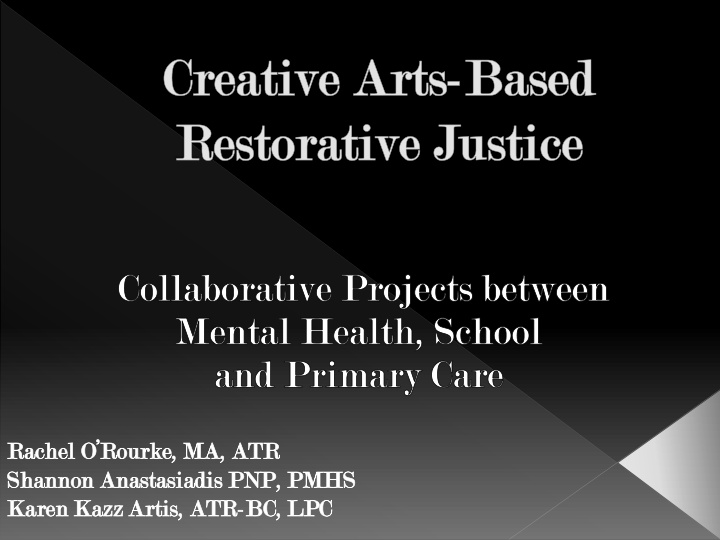



Rachel O’Rourke, MA, ATR Shannon non Anasta stasia siadi dis s PNP, PMH MHS Kare ren n Kazz Art rtis, , ATR-BC, BC, LPC
How can creative arts-based restorative justice help high-risk adolescents? How do health care providers, mental health care providers, school counselors and school administration collaborate to develop arts based restorative justice groups for adolescents in school based clinics? How can groups serve as a gateway for adolescents to increase their use of the school based clinic services?
Healing over punishment “justice” Collaboration Inclusion over exclusion Positive Community Support Circle/Continuous Process
The Creative Arts can: Promote self expression Build creative thinking Involve risk taking Expand perception Promote self reflection Encourage expression of emotions Foster respect of self and others Increase empathy
ACCESS Holistic Intervention Relationship Building with Whole Team Positive Impact upon how School Counselors and Administrators view SBHC Expansion of Services Clinicians develop deeper understanding of each other’s Clinical Practice
Step 1: Information Sharing/Brainstorming Step 2: Assessing school needs, marketing to school staff and recruitment of group members based upon specific criteria (A high rate of in school suspensions and out of school suspensions, gender, behavior problems in school, poor academic performance and poor attendance records.) Step 3: First Group Meeting: Introductions, Expectations, Transparency/Self Disclosure (What does each person need to work on during group?), Group Rules, Group Philosophy from “Private to Public” and “Clean Slate”, Naming of Group and Brainstorming Step 4: Group leaders must be completely client centered and make sure to have good snacks. Parkrose SBHC RJP: Launched in February, 2013 Mondays for 60 minutes, weekly and bi-weekly in May, 2013. Originally scheduled for 10 weeks and extended to the end of the school year.
Qhianthony “ RJP is really helpful for me because it keeps me out of trouble.”
“RJP gives us something to look forward to because I believe each and everyone of us are born leaders.”
“So when I spread out my wings an’ do good things in the back of my mind I’m thinking RJP. “
“Our goal is just to stop the violence and the drugs and help people/kids go in the right direction.”
“ At this school I am perceived in bad ways. People see me as cocky but I am proud. Boastful but I am confident. “
The Restorative Justice Project group members wrote and received a grant from the Multnomah County Youth Commission to support this event.
Step 1: Group leadership/Collaboration/Art Therapist, Intern and Teacher/ Information Sharing Step 2: Assessing school needs, marketing to school staff and recruitment of group members based upon criteria developed by group leaders. The group is made up of 6 to 8 female academically high achieving students from Somalia, Conga, Ethiopia, China and India. Some group members experienced war trauma and in their countries of origin from early ages. Group served as a gateway/connection to clinic and clinic services.
Relationships Group members with clinician Then group members with peers – supporting them to access clinicians
Contraceptive services Individual mental health services Skin related issues Sports injuries
Choose a piece of paper, place your right hand on the paper and write one word on your hand to represent a strength you bring to your work then place your left hand on the paper and write one word to represent a strength you will take away from your experience today to incorporate into your work Pose your hands on the paper at one of the photo stations Photographs of all hands will be displayed in an installation near the exit of the conference As you leave please feel free to take your photograph with you
Recommend
More recommend